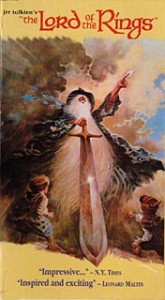 Sarah Meador penned this review.
Sarah Meador penned this review.
Ralph Bakshi’s Lord of the Rings makes a startling assumption for an American cartoon feature. While most animated features seem to take it on faith that their audience will be musical-loving children, Lord of the Rings is geared towards the adult fantasy fan and thus emphasizes the darker, more threatening nature of Middle Earth. Bakshi’s more realistic character designs and rotoscope-aided movement animation also add to the serious feel of the movie.
This isn’t to say the film is an unqualified success. There are flaws, some of them laughable. The most humorous is the prevalence of Big 1970’s Hair. Nearly every character is given a hairstyle that might have looked normal at the time of the film’s release but has not aged well. Gandalf and Saruman are both especially burdened with massive hair, as well a tendency towards extreme gesticulation. Gandalf seems incapable of ordering tea without simultaneously signaling at passing aircraft, and Saruman is constantly posed to make snow angels. The more serious flaws go beyond design issues, and have to do with Bakshi’s directorial faults. Battle scenes both small and large suffer from horrible pacing, with the encounter of the Nazgul at the ford being particularly painful (I actually began checking my watch, which is a bad reaction to a battle scene). They get worse as the film progresses, becoming increasingly muddy and hard to follow, and much too slow to care about.
And then there’s that infamous Bakshi rotoscoping. Rotoscoping is an animation technique where live footage is basically used as the pencil drawing, with the animation cel being traced and painted over it. Many animators, including Bakshi himself, have used it to good effect. He does so here. Character movements are more lively and realistic than typical in animation, but without the jarring sense that these are somehow real people being caricatured. Rotoscoping may also have helped create the truly wonderful facial expressions, which show a subtlety and range almost never seen in animation. But rotoscoping can be used for evil, as it is in the crowd scenes here, especially when Bakshi takes it a step further and stops using live footage as a guide, but as actual material. Starting with the crowd in The Prancing Pony, crowds aren’t animated at all — they are just blatant live-action footage that has been solarized to wash out the natural colors, then tinted with overlays. This is even worse for the crowd scenes that are also battle scenes, as they quickly fill up with orcs that are obviously living actors, wearing masks, who have been clumsily filmed in silhouette.
Still, the live-action shadow technique isn’t a complete failure. Bakshi uses it quite effectively in the opening narration of the film. This sequence is brief and well told: the faceless quality of the silhouettes adds to the sense that this is an old story, and the sequence itself conveys Gollum’s backstory, which is what makes him worse than just a monster.
The lovely character expressions are largely equaled by the voice acting . Frodo and Gollum are especially well cast; Frodo manages to sound strained without crossing over into whining, and Gollum’s mad ramblings hold the perfect line between threat and pitiable insanity. The sheer amount of material included in the film (it covers about half of the Rings trilogy) means that the dialogue tends to be brief, but the whole script serves to enhance the characters, and the actors make every line count. The expressive voices are matched by the character designs: Gollum looks every inch the degraded, deformed Hobbit he is; Legolas has a grace and a glow that live-action simply doesn’t allow for; and even 70’s-style hair can’t distract from Gandalf’s preybird eyes.
All this great character work means that the best moments in the film aren’t the grand battle scenes, but the small moments shared between individuals. Bilbo’s moment of Gollum-like ring fixation, Boromir’s low-key feuds with Aragorn, Galadriel’s self-mocking laugh when Frodo offers her the Ring; these added more character to the story than any number of spectacular fight scenes. Character development fan that I am, I’m willing to accept a badly-costumed Balrog in exchange for Sam’s frantic terror when he looks into the Mirror.
This film is not perfect. The battle scenes are abysmal, and the odd stopping point (around the middle of the second book) means that some of the introduced characters never get a chance to show their importance. And, of course, there are things edited out; Tolkien purists will lament the absence of Tom Bombadil or Glorfindel or any other scene snipped in pursuit of brevity. But the heart of the story remains intact, and I finished the film really caring about the members of the Fellowship and distressed over the plight they were all in. I was also greatly distressed that there was no sequel, and in spite of having read the trilogy, I was eager to know what happened next. Ralph Bakshi’s adaptation of The Lord of the Rings won’t suit everyone, but for those willing or able to overlook the effects of budget constraints, there is magic here.
(Warner Brothers, 1978)
[]
